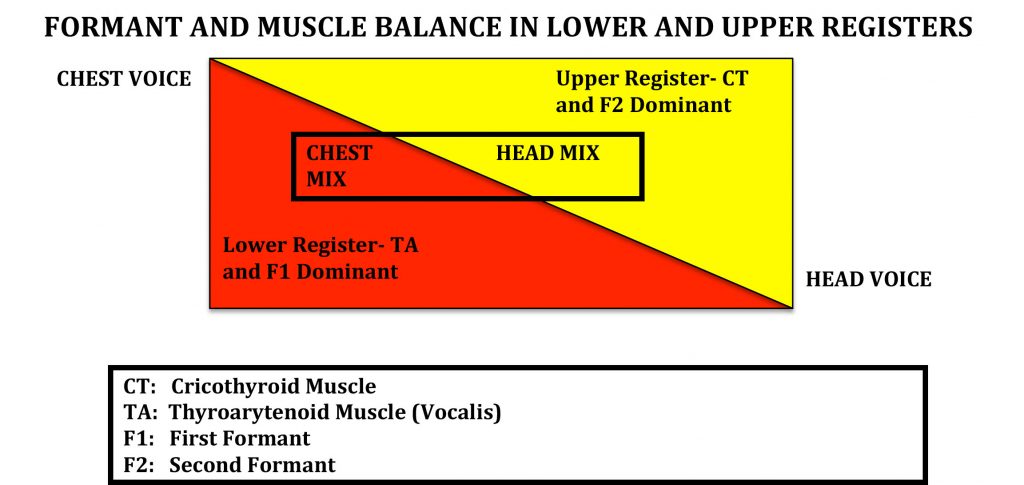Singing with Balance: Muscles

As we learned in Steps One through Five, the voice is a system with various components that must work in a coordinated fashion. Think of a system such as a car engine; if one component of that system, such as the piston, is not functioning properly the system as a whole will not work.
The system of vocal production is like that- if one component is not functioning efficiently, the entire system suffers.
We train and develop each component of the vocal production system with The Eight Steps of Vocal Development. Our objective is to coordinate and balance each component of the system so the voice will function reliably and efficiently.
To review how your voice works: the vocal folds, the vibrator of the system, are located in the larynx or Adamʼs Apple.

Air pressure from the lungs (the generator of the system) causes the folds to open and close very quickly, converting aerodynamic energy to acoustic energy containing a fundamental frequency (pitch) plus partials called harmonics that are boosted or attenuated (damped) in the containers of air in the pharynx (throat) and mouth.
- The Respiratory System is the Generator (generates air pressure).
- The Vocal Folds are the Vibrator (resist air, converting aerodynamic energy to acoustic energy).
- The Vocal Tract is the Resonator (a filter that boosts or attenuates harmonics to produce timbre).
THE SEVEN PARAMETERS OF VOCAL BALANCE
Good singing is all about balance. In good singing, the voice functions efficiently as a system, due to the coordination of acoustic and muscular activity.
There are seven parameters of vocal balance vital to excellent singing.
PARAMETER ONE: BALANCE OF TA (Thyroarytenoid Muscle) and CT (Cricothyroid Muscle) ACTIVITY
The TA and CT muscles are always working together. TA shortens and thickens the folds, and CT lengthens and thins the folds.
To sing higher pitches, there must be a handoff from TA-dominant to CT-dominant vocal fold vibration. The handoff will happen naturally with the selection of the correct vowel, minimal air pressure, and a stable laryngeal position that allows the cricothyroid or CT muscles to tilt the thyroid cartilage and thus lengthen the vocal folds.
Pitch is changed by alterations in the length, thickness, and tension of the vocal folds. This is controlled by the coordination of the TA and CT muscles, responsible for shortening and lengthening the vocal folds.
These muscles must work together cooperatively to enable consistent vocalization from low to high without straining or cracking.
In the chest voice or lower register, the TA muscles are more active and the vocal folds are shorter and thicker as the TA muscles contract the body of the vocal folds. As the TA muscles contract, the vocal folds, comprised of the TA and vocalis muscles, mucosa, and ligament, shorten and push toward one another.
To sing higher, the CT muscles become progressively more active, tilting the thyroid cartilage forward so the vocal folds become longer and tauter, while the TA muscles reduce activity.
Both muscle groups are active in the lower register- the CT muscles work against the contraction of the TA to raise the pitch. To sing higher, however, the CT muscles and ligament become more active; on the highest pitches, the TA muscle is quiescent.
A smooth handoff requires coordinating both muscle and resonance. This coordination is something that needs to be developed- few singers are gifted with a naturally balanced voice.

Belters take the TA-dominant phonation beyond the primo passaggio. Breathy Light Lower category singers bring the CT-dominant phonation too low, creating a breathy, weak tone in the lower register. These are examples of unbalanced registration.
When singing from low to high, good contemporary singers use mixed registration, transitioning through the primo passaggio with connected release to the upper register rather than holding on to the familiar lower register.
The vocal folds cannot remain static; we have to let go of what feels natural or familiar to experience mix. The coordination of TA and CT muscle activity is necessary for this connected release.
If you would like to learn more about your voice AND learn to sing from home for less than you probably spend for lattes every month, check out our amazing YOU can Sing Like a Star online subscription courses for singers and voice teachers.
You can learn to sing with a self-study method- IF it's the right method. The ONLY method that can take you from beginner to professional is the YOU can Sing Like a Star online subscription course with over 600 recorded exercises.
This is the best method available and the ONLY method that takes you all the way from beginner to professional singer- for far less than the cost of in-person voice lessons!
Check this amazing course out at YOU can Sing Like a Star online subscription course.
If you are a voice teacher who wants to up your game, check out the YOU can be a Successful Voice Teacher online subscription course
With over 600 recorded exercises, including Riffs and Runs- Style, you don't need to be a great pianist or vocal stylist to be a great teacher!



